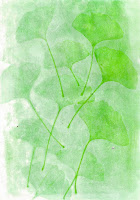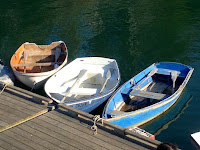 |
| row boats in the sun |
Relief prints can be made from any flat surface that can be carved, wood and linoleum being the most common. The use of linoleum dates back to around 1913.
Linoleum is easier to carve then traditional wood blocks, requiring less expensive tools. Unlike wood,
linoleum has no grain, allowing for large areas of flat color and a greater variety of textures.
I choose a photo I took of three row boats tied to a dock at Isle au Haute, Maine for my subject. The photo has large shapes with dark colors, deep shadows, whites and bright sun light.
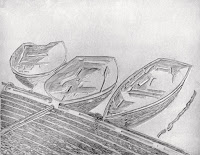 |
| Linocut |
I traced the shapes in the photo to the linoleum using graphite paper. Then used a sharpe pen to mark all the lines and areas that needed to be carved away.
I used
speedball carving tools, starting with the knife to outline shapes to be carved. The 2V tool was also used to outline, and make medium lines. The larger 2V and 5U tools were used to remove large amounts of linoleum inside the bigger shapes. The smaller 1V blade was used to create small precise lines, and the 1V, 2V and 3U shaped blades were used to add texture to the boat hulls and dock.
The finished linocut was inked with a thick dark blue ink and places on the printer bed ink side up. Paper was carefully placed on top of the linocut. The bed was slid under the printers roller. The
ink on the linocut adheres to the paper creating a
reverse image. The amount of ink transferred depends on the viscosity of the ink, the amount of ink on the linocut, the type of paper and amount of pressure imparted by the press during printing. The first print didn't have enough ink or pressure. I lowered the roller a bit and re-inked the linocut with thinner black ink. The resulting second print came out much better with sharp lines and smooth consistent areas of color.
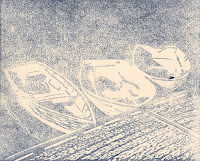 |
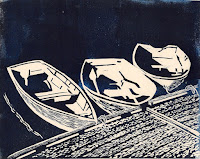 |
| First print | Second print |
Now that I was done printing, the remaining ink on the Linocut needed to be removed. You can use
several solvents to remove oil based inks, I used
vegetable oil. I applied some vegetable oil and started rubbing with a paper towel, but stopped. There was still a lot of ink on the linocut so I decided to try using a marble rolling pin and paper towels to pull most of the ink off first. I was very successful at pulling the majority of ink off the linocut. I finished up by rubbing the remaining ink off with vegetable oil. Below is the first paper towel rolling pin print, which was interesting enough to keep. You can see the paper towel pattern, remnants of black and dark blue ink, as well as a lighter circle where I started to remove the ink in the upper left.
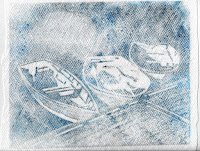 |
| Paper towel print |





















